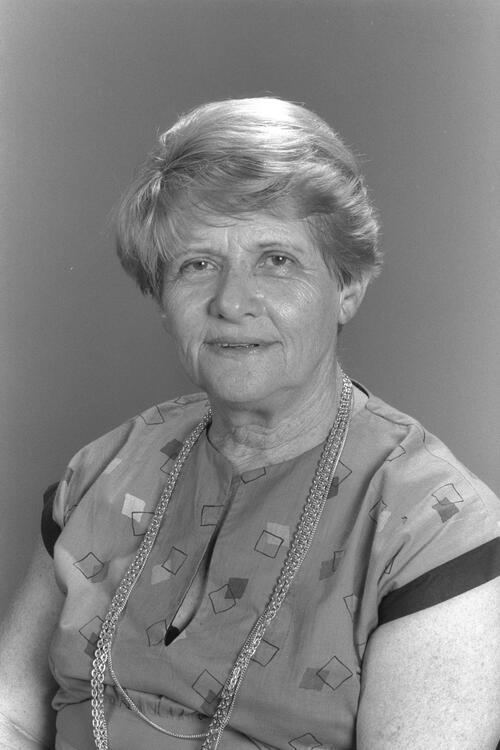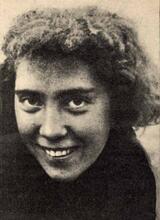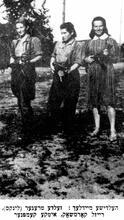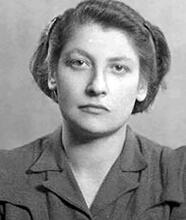Haika Grosman
Grosman was born in Poland in 1919 and joined Ha-Shomer ha-Za’ir, the Jewish Socialist youth movement, at age eleven. She was admitted to the Hebrew University in 1938 but postponed her plans when the “movement” asked her to remain in Poland. Following the outbreak of World War II, Grosman was elected a mem er of the “alternative leadership” of the movement in Warsaw; when Poland succumbed to the Germans, Grosman fled east to Vilna, Lithuania. Soviet capture of Lithuania forced the movement to retreat underground. Relying on her Aryan looks, Grosman took up residence just outside the Vilna ghetto and reported information back to underground operatives. Grosman delivered information between ghettos and the underground and maintained a strict personal appearance so as not to attract attention from the authorities. Grosman was finally able to make Aliyah to Israel in 1948, in the midst of the War of Independence, and integrated herself into the kibbutz lifestyle. She later served as a Knesset member and actively voiced her desire for peace with the Arabs and was against seeking revenge for the Holocaust.
Childhood
Haika Grosman was born in Bialystok on November 20, 1919. She was the third and youngest child of Nahum (1890–1942) and Leah (née Apelbaum) Grosman (1891–Treblinka, August 1943), a member of a wealthy family imbued with Jewish tradition and culture, living in a city half of whose residents (about sixty thousand) were Jewish. Her father was a factory owner, from whom, she alleged, she inherited her looks: “short, blue-eyed, blond.”
Grosman, who spoke Yiddish and Hebrew as her mother tongues, learned Polish at school. She studied at the highly esteemed Tarbut gymnasium, excelling in the humanist subjects. “I got the best of everything,” she wrote in her memoirs, “pretty clothes that my mother and sister forced upon me—books, of which I took care myself.” From early childhood her life had been intertwined with the Jewish-Zionist experience. As an eleven-year-old child, Grosman joined Ha-Shomer ha-Za’ir, the Jewish socialist youth movement that attracted the elite of Jewish youth. A movement that educated towards a socialist ideology as well as immigration to the land of Israel, it also encouraged the study of social sciences and Yiddish literature and folklore.
Plans on Hold
Grosman advanced to the position of an active instructor and became an exciting speaker. Upon the completion of her studies in Bialystok in 1938, she registered for the Hebrew University in Jerusalem, was admitted, and received an immigration certificate. But the “movement” leadership explained to Grosman that she was still needed and that she should continue coordinating instruction in the communes of the “movement” in east Poland. Being a conscientious and loyal member of the “movement,” Grosman accepted the verdict and decided to postpone her immigration. This was the first but not the last time that she gave up her personal plans in order to harness herself to the public good.
Outbreak of World War II
A few days after the outbreak of World War II, the leaders of the movement rushed Grosman to Warsaw, where she was notified that she had been elected a member of “the alternative leadership” designed to lead the “movement” during war, since the more experienced leadership, well known by the authorities, was compelled to retreat eastward. Grosman was nineteen at the time. In September 1939, Poland succumbed to the German troops. Thousands of Jewish refugees filled the roads eastward, making for the territories occupied by the Russians. Among them were the youngsters of the Halutzic youth movements. Grosman reached Vilna (Vilnius), where she assumed the task of instructing the graduates in the huge commune in Kovno (Kaunas). When the Soviet army conquered Lithuania and the communes went underground, she returned to Vilna and became involved in underground activity. The “certificate for aliyah” reached her once again. Once more, the “movement” informed her that she was needed and Grosman decided to stay. With the German invasion of the USSR in June 1941, Vilna was captured. Thousands of youngsters, including the most outstanding ones in her movement, turned eastward. At a street corner in shelled Vilna the members of the young leadership gathered for a quick consultation. They decided to leave. Grosman announced that she was staying. As a woman, it would be easier for her to move; moreover, her Aryan looks would protect her.
Underground Movement
Thousands of Vilna Jews were captured and deported to the mass extermination site of Ponary, ten kilometers from Vilna. On September 6, 1941, the few Jews remaining in the city were transported to the Ghetto. Grosman, adopting a false identity, moved outside the Ghetto, crossed the border lines of occupation zones, and reached the members of the ”movement” in numerous ghettos, including Warsaw, where she reported about the mass murders taking place in east Poland. She participated in the “movement” gathering in a convent near Vilna, where the group, led by Abba Kovner (1918–1988), decided on armed resistance. Sent to Bialystok to organize the fighting underground, she served as a contact person between Vilna and Bialystok and other ghettos. Grosman was a good-looking young woman who maintained an almost elegant presence even in wartime conditions, performing potentially dangerous missions. Her “ammunition” was resourcefulness, arrogance, courage, strong nerves and constant alertness, all of which saved her from virtually hopeless situations. “My rule” she said, “was not to hold on to sentiments. My purse was always clean—no personal photographs, no memories. I never wrote a word, kept neither diary nor notes. Everything was measured and calculated.” In the ghetto she and her close friend Edek Borks (d. 1943) shared in an ongoing attempt to unify the underground of the Zionist and Communist youth movements. She served as the central figure in the negotiations with Efraim Barasz (1892–1943), chairman of the Bialystok Judenrat (Jewish Council), to induce him to enable underground activity and to gain his support. The unified front, headed by Mordechai Tennebaum (1916–1943), had been formed only on August 16, 1943, the eve of German action to exterminate the Bialystok Ghetto. The desperate uprising which broke out was soon suppressed by the Germans, who had learnt the lesson of the Warsaw Ghetto. Grosman succeeded in escaping to the Aryan side, taking a hasty farewell of her mother, who was in the convoy of deportees.
Anti-Fascist Committee
Between August 1943 and August 1944, Grosman participated in forming a group of six women in Bialystok, called “the anti-fascist committee.” The aim of their hazardous activity was the ongoing maintenance of contact with the Soviet partisan brigade in the forest: they led Jews to them, established relations with anti-fascist Germans in the town, and used their help to acquire ammunition for the underground and the partisans. With the surrender of the German troops, Grosman and her friends marched in the front line, side by side with the Soviet Brigade fighters who entered the city in August 1944. Grosman, who was awarded the highest national medal for utmost courage by the Polish government, stayed in Bialystok, but declined her friends’ repeated appeal to officially join the communist leadership. At the same time, she integrated into the new regime, and served in the security forces tracing Nazi collaborators. At this time, the end of 1944 and beginning of 1945, the remaining leadership of the Halutz movements were looking for a way to reach the survivors of the camps and the refugees who had returned from central USSR. The members of Ha-Shomer ha-Za’ir in Poland located Grosman and, in an emotion laden meeting, told each other about the hardships and horrors of their personal experiences. Informing her superiors in the security forces that she was joining her Jewish Zionist comrades, Grosman reached the joint commune in Warsaw in April 1945. Until her immigration to Israel in May 1948, she operated mainly in the political field, serving as head of the youth department in the Central Jewish Committee formed by the Polish authorities. As an acknowledged hero of war, she established political connections which helped her to organize institutions for the absorption of refugee children. At the same time, she became the central figure who, together with Yitzhak Zuckerman (Antek; 1915–1981) promoted the establishment of an umbrella movement which included all the pioneering movements, in the belief that unity was necessary for the rehabilitation of the survivors and for their immigration to Palestine. With Antek, she participated in the first conference of the Zionist leadership, held in London in August 1945. Although the two handsome people, representatives of Jewish heroism in the Holocaust, were met with great admiration, they continued to feel the loneliness of their struggle. In London, Haika for the first time experienced the burden of the Yishuv’s political dominance. Ya’akov Hazan (1899–1992) and Meir Ya’ari (1897–1987), the leaders of Ha-Shomer ha-Za’ir, instructed her to act against the unification of the Halutz movements established in Poland. Grosman resisted and argued, but finally accepted the verdict. In 1946, another delegation in which she participated was sent to the USA. She returned from there glorified, carrying at the bottom of her suitcase twenty-five thousand dollars for rescue and rehabilitation activities.
Emigration to Israel
In 1948 Grosman arrived in Israel in the midst of the War of Independence. A highly experienced young woman, a leader without any troops, she was greeted with great excitement, but was expected to prove herself anew. At A voluntary collective community, mainly agricultural, in which there is no private wealth and which is responsible for all the needs of its members and their families.kibbutz Evron she was met by her pre-war group leader, Meir Orkin (b. 1914) whom she married. On September 21, 1949, a day after completing her monumental book, The People of the Underground, Haika gave birth to her first daughter, Leah. In this book she described the sufferings of the members of Ha-Shomer ha-Za’ir and other movements, as well as of the Jews in Vilna and in Bialystok. In 1950 she was elected to head the local council of Ga’aton, a region which included A voluntary collective community, mainly agricultural, in which there is no private wealth and which is responsible for all the needs of its members and their families.kibbutzim, transit camps of new immigrants and Arab villages. Herself a new immigrant, Grosman became involved in the rehabilitation of post-war populations, both Arabs and Jews, expertly handling the sensitive issues of land, unemployment, and housing. She soon integrated into kibbutz life, working in the kitchen, instructing youngsters and serving as kibbutz secretary, but her political instincts left her restless. She became secretary of Mapam (pioneering left-wing Labor Zionist party) in the Haifa area, participating in the struggles of workers’ unions. In 1969, she was elected to the Lit. "assembly." The 120-member parliament of the State of Israel.Knesset as a representative of Mapam, at that time in an alignment with the Israel Labor Party. In the Knesset Grosman served as the head of the Committee of Public Services. Her main interest and contribution focused on legislation on social issues, youth in distress, women’s status and striving for equality, care for poverty-stricken neighborhoods, health and problems of the elderly. She was also active in ongoing discourse with the Arab population of the country. Towards the end of her activity in the Knesset she coordinated the Mapam faction and became deputy speaker of the House.
Memory of the Holocaust
Grosman resumed her occupation with Holocaust memory in the kibbutz movement and in Israel when she was already an important public figure. In 1988, after the death of Rozka Korczak, she was appointed as chairperson of Moreshet, coordinating extensive educational activities for inculcating Holocaust memory. She also participated in the publication of books and periodicals, while devoting most of her energy to fund-raising for the establishment of a house of commemoration to the activities of the Halutz youth movements during the Holocaust, a project which she was unfortunately unable to accomplish.
Fight for Recognition
Grosman was a woman of integrity who never hesitated to voice her beliefs in an open manner. In 1945, at a conference in London, she confronted the participants with the words: “The war has been over for months and neither messenger nor money has arrived from Erez Yisrael.” Although she was selected by her party as a candidate for the Israeli cabinet, she proceeded to lead opposition to joining the government because its platform was not in accord with the party’s principles. In her meetings with world leaders she never refrained from reprimanding them, as she did with the Polish premier, Myeczyslaw Rakovsky, for the latter’s accusations against Jews during the economic crisis. She scolded the Russian Foreign Minister, Evgeny Primakov, for his support of Arab nationalism, and German leaders for their dismissal of German responsibility for Nazi acts. She spoke in a clear and direct voice. Her political opponents in Israel respected her for her integrity and positions. Menahem Begin (1913–1992) regarded her as a “sister fighter.”
While Grosman fulfilled all the duties of a kibbutz member, she also insisted on an elegant and stylish appearance, which was most uncommon among female kibbutz members at the time.
Dedication to Peace
Grosman, who matured in the Holocaust, who experienced the horror, fought and survived, strongly objected to revenge operations after the war and opposed hatred of the other as the last resort of the victim. In her political life she consistently advocated full civil equality for the Arab population, as well as social justice and peace. As her last public mission she accompanied Prime Minister Yitzhak Rabin (1922–1995) to the memorial services in Poland on Holocaust Memorial Day in 1993.
On the Eve of Independence Day in 1993, Haika was awarded the honor of lighting a torch at the Mount Herzl opening ceremony. At a party in Abu Ghosh held at the home of Muhammad Musa Abu Ghosh, Grosman said: “I am most gratified to have been honored as an ex-member of Knesset and as a Holocaust survivor to light a torch alongside an Arab who connected his fate to the State of Israel. I feel the steps of peace approaching.” At the end of the party, on her way out, she stumbled over the steps, fell and suffered brain injury. For three years she lay unconscious, supported by her husband, family and kibbutz members. She died on May 26, 1996.
Selected Works
Hebrew
The People of the Underground. Merhavia: 1965.
“A Confession—Almost.” Yalkut Moreshet 69 (May 2000): 3–27.
M. Gefen, H. Grosman, S. Holavski, Y. Segal, A. Kovner, and R. Korczak, eds. The Jewish Partisan. Merhavia: 1958.
“Holocaust and Resistance.” In Ha-Shomer ha-Za’ir in Poland 1913–1950, edited by Josef Shamir, 217–245. Tel Aviv: 1991.
“The Underground Activity of the Remains in Bialystok.” In The Jewish Partisan, edited by M. Gefen, H. Grosman, S. Holavski, Y. Segal, A. Kovner, and R. Korczak, 259–310. Merhavia: 1958.
“They Were Not Spoiled or Romantic.” In And You Shall Tell Your Child, edited by Meir Orkin. Tel Aviv: 1990.
“Otto Bussa: The Believer, The Helpmate.” Yalkut Moreshet 28 (November 1979): 131–134.
“After Forty Years.” Yalkut Moreshet 39 (May 1985): 85–90; “The Nature of Young People in the Revolt.” Yalkut Moreshet 43 (August 1987): 149–158.
“The Ghetto Uprising Emerged from the Certainty of Extermination.” Yalkut Moreshet 47 (November 1989): 97–104.
Orkin, Meir, ed. And You Shall Tell Your Child (Hebrew). Tel Aviv: 1990.
Shamir, Josef, ed. Ha-Shomer ha-Za’ir in Poland 1913–1950 (Hebrew). Tel Aviv: 1991
“In Memory of Haika Grosman.” Yalkut Moreshet 62: (October 1996).







